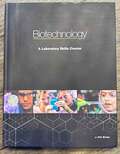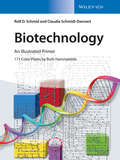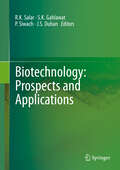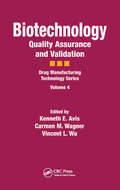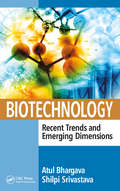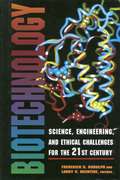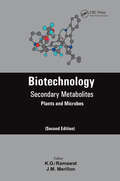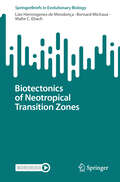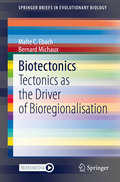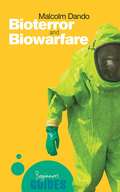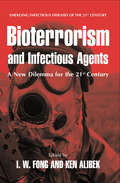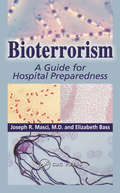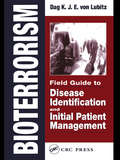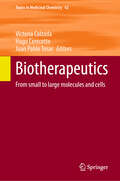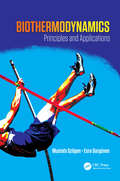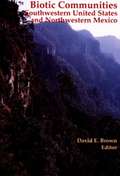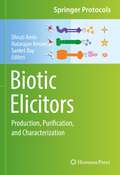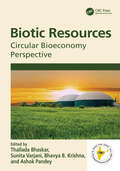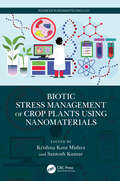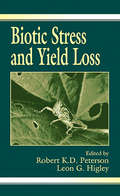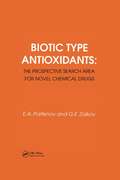- Table View
- List View
Biotechnology: A Laboratory Skills Course
by J. Kirk BrownThis laboratory textbook blends theory with hands-on laboratory activities and real-world applications for your biotechnology course, and it incorporates Bio-Rad Explorer kits for easy implementation. This Develops key skills with multiple activities. Encourages students to consider the implications of biotechnology with bioethics case studies. Broadens occupational awareness with profiles of careers in biotech. Lets students answer a research question using independent research. The teacher supplement provides a thorough background on preparation, setup, results analysis, and assessment. It also provides guidance on how to implement and build a biotechnology course.
Biotechnology: An Illustrated Primer
by Rolf D. Schmid Ruth HammelehleNow presented in large format, the new Schmid is the ideal primer in biotechnology. The two-page layout with one page being a full color figure and the opposite page being explanatory text is the ideal combination between rapid visual-based learning with in depth information.
Biotechnology: Prospects And Applications
by R. K. Salar S. K. Gahlawat P. Siwach J. S. DuhanBiotechnology: Prospects and Applications covers the review of recent developments in biotechnology and international authorship presents global issues that help in our understanding of the role of biotechnology in solving important scientific and societal problems for the benefit of mankind and environment. A balanced coverage of basic molecular biology and practical applications, relevant examples, colored illustrations, and contemporary applications of biotechnology provide students and researchers with the tools and basic knowledge of biotechnology. In our effort to introduce students and researchers to cutting edge techniques and applications of biotechnology, we dedicated specific chapters to such emerging areas of biotechnology as Emerging Dynamics of Brassinosteroids Research, Third generation green energy, Bioremediation, Metal Organic Frameworks: New smart materials for biological application, Bioherbicides, Biosensors, Fetal Mesenchymal Stem Cells and Animal forensics. Biotechnology: Prospects and Applications will be highly useful for students, teachers and researchers in all disciplines of life sciences, agricultural sciences, medicine, and biotechnology in universities, research stations and biotechnology companies. The book features broader aspects of the role of biotechnology in human endeavor. It also presents an overview of prospects and applications while emphasizing modern, cutting-edge, and emerging areas of biotechnology. Further, it provides the readers with a comprehensive knowledge of topics in food and agricultural biotechnology, microbial biotechnology, environmental biotechnology and animal biotechnology. The chapters have been written with special reference to the latest developments in above broader areas of biotechnology that impact the biotechnology industry. A list of references at the end of each chapter is provided for the readers to learn more about a particular topic. Typically, these references include basic research, research papers, review articles and articles from the popular literature.
Biotechnology: Quality Assurance and Validation
by Kenneth E. Avis Carmen M. Wagner Vincent L. WuBiotechnology: Quality Assurance and Validation provides a practical, detailed discussion of what issues Quality Assurance and Quality Control need to identify for effective control in the preparation of biotechnology products. The book presents a series of topics that define some of the unique challenges facing biotechnology companies in producing biopharmaceutical products. The topics selected address quality and validation issues, starting with the cryopreservation of cell lines through the filling and finishing of the product. It includes a validation guide, a clear presentation of how to use filtration effectively, a synoptic view of cleaning procedures, and much more.
Biotechnology: Recent Trends And Emerging Dimensions
by Atul Bhargava and Shilpi SrivastavaBiotechnology is a multidisciplinary field encompassing microbiology, bichemistry, genetics, molecular biology, chemistry, immunology, cell and tissue culture physiology. This book describes the recent developments in these areas. Current research topics such as Quorum sensing, Integrons, Phytomining are discussed, which would serve as an excellent reference work for both academicians and researchers in the field.
Biotechnology: Science for the New Millennium
by Ellyn DaughertyThis complete program teaches the concepts and hands-on lab procedures required for entry-level careers in the rapidly growing biotechnology industry. The textbook and lab manual can be used together or separately, depending on the desired course format.
Biotechnology: Science for the New Millennium
by Ellyn DaughertyThe new edition of Biotechnology: Science for the New Millennium is the perfect textbook and lab manual combination program for your classroom! Designed for introductory courses, this complete program teaches the concepts and hands-on lab procedures required for entry-level careers in the rapidly growing biotechnology industry. The textbook and lab manual can be used together or separately, depending on the desired course format.
Biotechnology: Science, Engineering, And Ethical Challenges For The Twenty-First Century
by Frederick B. Rudolph Larry V. McintireBiotechnology-the manipulation of the basic building blocks of life-is rapidly advancing in laboratories around the world. It has become routine to refer to DNA fingerprints and genetically engineered foods.Yet the "how to" of biotechnology is only the beginning. For every report of new therapies or better ways to produce food, there is a Jurassic Park scenario to remind us of the potential pitfalls.Biotechnology raises serious issues for scientists and nonscientists alike: Who will decide what is safe? Who will have access to our personal genetic information? What are the risks when advanced science becomes big business?In Biotechnology, experts from science, law, industry, and government explore a cross-section of emerging issues. This book offers straightforward explanations of basic science and provides insight into the serious social questions raised by these findings.The discussions explore five key areas: The state of the art in biotechnology-including an overview of the genetic revolution, the development of recombinant DNA technology, and the possibilities for applying the new techniques. Potential benefits to medicine and the environment-including gene therapy, the emerging area of tissue engineering and biomaterials, and the development of therapeutic proteins. Issues in technology transfer-focusing on the sometimes controversial relationship between university research centers and industry. Ethics, behavior, and values-exploring the ethical issues that surround basic research and applications of new technology, with a discussion of scientific misconduct and a penetrating look at the social impact of genetic discoveries. Government's role-including a comparison of U.S., European, and Japanese policies on pharmaceutical and biotechnology development. Biotechnology is here to stay, and this volume adds immeasurably to understanding its multiple aspects and far-reaching implications. This book will be of interest to scientists and industry leaders involved in biotechnology issues-and it will be welcomed by the concerned lay reader.Frederick B. Rudolph, Ph.D., is a professor of biochemistry and cell biology at Rice University and is executive director of the Institute of Biosciences and Bioengineering.Larry V. McIntire, Ph.D., is the E. D. Butcher Professor of Chemical and Biomedical Engineering at Rice University and is chair of the Institute of Biosciences and Bioengineering.
Biotechnology: Secondary Metabolites
by K.G. RamawatThis book provides new information relating recent advances made in the field of plant secondary products. Besides the updation of chapters this edition also includes chapters on secondary metabolites of microorganisms (fungi and lichen).
Biotectonics of Neotropical Transition Zones (SpringerBriefs in Evolutionary Biology)
by Malte C. Ebach Bernard Michaux Lize Hermógenes de MendonçaThis book offers an up-to-date review and synthesis of the role of tectonics in Neotropical bioregionalisation, in particular transition zones. The main questions are "What are transition zones?", "How would we identify them?" and, "What are the tectonic drivers of transition zones?" These questions are pertinent as they may reveal a new transition zone within the Caribbean (Antillean sub-region), and provides an up-to-date account of the biotectonics of the Caribbean. In addition, the book contains a detailed tectonic summary of the development of the Andes and the bioregionalisation of the South American Transition Zone.
Biotectonics: Tectonics as the Driver of Bioregionalisation (SpringerBriefs in Evolutionary Biology)
by Malte C. Ebach Bernard MichauxTectonic plates are constantly moving, either crashing into one another creating a mosaic of mountains and shallow seas, or tearing apart and isolating large swathes of land. In both cases plate tectonics separates populations leading to the evolution of biota. Tectonics is also responsible for the destruction life, for instance when large coral reefs or shallow seas are compressed to form mountain peaks. Could recent research into these processes provide enough evidence to show that tectonics may be the ultimate driver of life on Earth? Our book delves into the current research in tectonics, particularly neotectonics, and its impact on rapid changes on biogeographical classification, also known as bioregionalisation. We also introduce a new term biotectonics that studies the impact of tectonics on biogeoregionalisation. The question we ask is how tectonics directly influences the distribution of biota in four case studies: the Mesozic and early Palaeogene Australides, which spans the Proto-Pacific coast of the South America, Antaractica and Australiasia; and the Neogene of Australia. To conclude we examine the role of neotectonics on tranistion zones and the Amazon Basin and make a case for biotectonic extinction.
Bioterror and Biowarfare: A Beginner's Guide (Beginner's Guides)
by Malcolm DandoIn this essential guide to the past, present and future of bio-warfare, international security expert Malcolm Dando draws a wealth of experience and research to uncover the truth about the alarming failure of international community to place effective curbs on the use of this deadly weapon.
Bioterrorism and Infectious Agents: A New Dilemma for the 21st Century (Emerging Infectious Diseases of the 21st Century)
by Kenneth Alibek I. W. FongCompiled by two leading experts in the field, this volume provides a concise, timely, and authoritative review of some of the most problematic infections of the new century. It presents issues and new ideas for preventing and controlling infectious diseases.
Bioterrorism: A Guide for Hospital Preparedness
by Elizabeth Bass Joseph R. Masci M.D.In the battle against bioterrorism, one of the greatest challenges is finding the ideal balance between complacency and overreaction. The goal is to be so well prepared that we can prevent catastrophic outcomes in the event of a bioterrorist attack, while strengthening our ability to prevent and treat naturally-occurring infectious diseases.Bioterr
Bioterrorism: Field Guide to Disease Identification and Initial Patient Management
by Dag K.J.E. von LubitzThe outbreak of anthrax infections that followed September 11, 2001, showed all too clearly that while we can defend ourselves against bioterrorism, our defenses need improvement. What's most important is the ability to recognize the associated disease, and recognize them quickly. Yet, many in the medical world are unfamiliar with the characteristi
Biotherapeutics: From small to large molecules and cells (Topics in Medicinal Chemistry #42)
by Victoria Calzada Hugo Cerecetto Juan Pablo TosarThis book reviews biotherapeutics from a medicinal chemistry perspective. It covers proteins, nucleic acids, low molecular weight hormones, small peptides, extracellular vesicles, gene therapy, cell-based products, and tissue-engineered products. Expert contributors provide insights into the mechanisms of action and translational processes of biotherapeutics. Particular attention is given to the latest developments in therapeutic proteins and nucleic acids. Biotherapeutic formulation developments like encapsulation, structural modifications and nanovehiculization are also presented in this book. Divided into 15 chapters, the book begins with basic concepts and definitions of biotherapeutics from a medicinal chemistry standpoint. The following chapters focus on therapeutic proteins, monoclonal antibodies, protein production, and structural modifications. Other chapters cover topics such as antisense oligonucleotides, aptamers, mRNA, gene therapy, as well as other biotherapeutics like low molecular weight hormones and small peptides. The book concludes with an overview of biotherapeutic formulations and an authoritative discussion on regulatory aspects. Throughout the book, readers will learn how biotherapeutics, whether obtained through bioprocesses or not, impact bioresponses and can be utilized for therapeutic purposes. Given its breadth, the book appeals to researchers in medicinal chemistry and biotherapeutics, scholars of medicinal chemistry, students at all levels of biochemical studies, practitioners in the medical field, and anyone interested in biotherapeutics.
Biothermodynamics: Principles and Applications
by Mustafa Ozilgen Esra Sorguven OnerOver the past several decades there has been increasing research interest in thermodynamics as applied to biological systems. This concerns topics such as muscle work and internal energy such as fat and starch. Applications of the first and second laws of thermodynamics to the human body are important to dieticians and health science experts, and applications of these concepts to the animal body are a major concern of animal scientists. This book covers these key topics, which are typically not covered in classic or traditional thermodynamics texts used in mechanical and chemical engineering.
Biotic Communities: Southwestern United States and Northwestern Mexico
by David BrownellBiotic Communities catalogs and defines by biome, or biotic community, the region centered on Arizona, New Mexico, Sonora, Chihuahua, and Baja California Norte, plus portions of California, Nevada, Utah, Colorado, Texas, Coahuila, Sinaloa, and Baja California Sur. This ambitious guide is an essential companion for anyone working in natural resources management and ecological research, as well as nonspecialists looking for solid information about a particular southwestern locale. Biotic Communities is arranged by climatic formation with a short chapter for each biome describing climate, physiognomy, distribution, dominant and common plant species, and characteristic vertebrates. Subsequent chapters contain careful descriptions of zonal subdivisions.
Biotic Elicitors: Production, Purification, and Characterization (Springer Protocols Handbooks)
by Natarajan Amaresan Dhruti Amin Sanket RayThis volume details techniques to study biotic elicitors involved in the field of agriculture for the benefit of the environment and growers. Chapters guide readers through protein, carbohydrate, lipid, glycoprotein and glycolipid components derived from microorganisms and their production, purification, and characterization. Authoritative and cutting-edge, Biotic Elicitors: Production, Purification, and Characterization serve as an essential resource for researchers in agricultural microbiology, plant biotechnology, and plant pathology. @font-face {font-family:"Cambria Math"; panose-1:2 4 5 3 5 4 6 3 2 4; mso-font-charset:0; mso-generic-font-family:roman; mso-font-pitch:variable; mso-font-signature:-536870145 1107305727 0 0 415 0;}@font-face {font-family:Calibri; panose-1:2 15 5 2 2 2 4 3 2 4; mso-font-charset:0; mso-generic-font-family:swiss; mso-font-pitch:variable; mso-font-signature:-536858881 -1073732485 9 0 511 0;}p.MsoNormal, li.MsoNormal, div.MsoNormal {mso-style-unhide:no; mso-style-qformat:yes; mso-style-parent:""; margin-top:0cm; margin-right:0cm; margin-bottom:8.0pt; margin-left:0cm; line-height:107%; mso-pagination:widow-orphan; font-size:11.0pt; font-family:"Calibri",sans-serif; mso-ascii-font-family:Calibri; mso-ascii-theme-font:minor-latin; mso-fareast-font-family:Calibri; mso-fareast-theme-font:minor-latin; mso-hansi-font-family:Calibri; mso-hansi-theme-font:minor-latin; mso-bidi-font-family:"Times New Roman"; mso-bidi-theme-font:minor-bidi; mso-fareast-language:EN-US;}.MsoChpDefault {mso-style-type:export-only; mso-default-props:yes; font-size:11.0pt; mso-ansi-font-size:11.0pt; mso-bidi-font-size:11.0pt; font-family:"Calibri",sans-serif; mso-ascii-font-family:Calibri; mso-ascii-theme-font:minor-latin; mso-fareast-font-family:Calibri; mso-fareast-theme-font:minor-latin; mso-hansi-font-family:Calibri; mso-hansi-theme-font:minor-latin; mso-bidi-font-family:"Times New Roman"; mso-bidi-theme-font:minor-bidi; mso-fareast-language:EN-US;}.MsoPapDefault {mso-style-type:export-only; margin-bottom:8.0pt; line-height:107%;}div.WordSection1 {page:WordSection1;}
Biotic Evolution and Environmental Change in Southeast Asia
by David J. Gower Kenneth G. Johnson James E. Richardson Brian R. Rosen Lukas Rüber Suzanne T. Williams David J. Gower Kenneth G. Johnson James E. Richardson Brian R. Rosen Lukas RüberThe flora and fauna of Southeast Asia are exceptionally diverse. The region includes several terrestrial biodiversity hotspots and is the principal global hotspot for marine diversity, but it also faces the most intense challenges of the current global biodiversity crisis. Providing reviews, syntheses and results of the latest research into Southeast Asian earth and organismal history, this book investigates the history, present and future of the fauna and flora of this bio- and geodiverse region. Leading authorities in the field explore key topics including palaeogeography, palaeoclimatology, biogeography, population genetics and conservation biology, illustrating research approaches and themes with spatially, taxonomically and methodologically focused case studies. The volume also presents methodological advances in population genetics and historical biogeography. Exploring the fascinating environmental and biotic histories of Southeast Asia, this is an ideal resource for graduate students and researchers as well as environmental NGOs.
Biotic Resources: Circular Bioeconomy Perspective
by Ashok Pandey Sunita Varjani Thallada Bhaskar Bhavya B. KrishnaThis reference book provides advanced knowledge on sustainable biogenic waste management. It covers innovative waste processing technologies to produce biofuels, energy products, and biochemicals. To create a circular bioeconomy, it is imperative to develop processes where the waste generated through one process acts as a feedstock for the other. This book discusses the latest developments in biochemical and thermochemical methods of conversion and covers the potential of different kinds of biomass in more decentralized biorefineries. It describes sustainable solutions for a greener supplement to fossil resources. The book is meant for microbiologists, chemists, and biotechnologists.
Biotic Stress Management of Crop Plants using Nanomaterials (Advances in Bionanotechnology)
by Santosh Kumar Krishna Kant MishraThis book summarizes nanotechnology-based agricultural research for crop productivity and the management of various plant pathogens. It deals with the application of nano-molecules for quick, cost-effective, and precise plant disease diagnostic procedures, plant pests and disease management, nano-pesticides, and nano-diagnostics. Further, it explains nanomaterials for biotic stress management, with an insight into the synthesis and modification of nanomaterials and their potential applications in different domains for disease management. Features include: Compilation of current research on the Nanomaterials as well as their versatile applications in plant biotic stress management Description of the role of nanomaterials as enzyme-mimicking nanoparticles, nano-pesticides, nano-fertilizers, and nanomaterials Review of day-to-day problems related to crop plants, their diagnostics, and stress management Exploration of trends in nanomaterial utility in diagnostics, enzyme-mimicking, and crop protection, and their possible role in plant disease management Study of pertinent nanomaterials including synthetic strategies, properties, chemistry, and applications This book is aimed at researchers and graduate students in plant pathology, genetic engineering, environmental science, botany, bioengineering, and nanotechnology.
Biotic Stress and Yield Loss
by Robert K.D. Peterson Leon G. HigleyUnderstanding biotic stress and plant yield allows for the practical development of economic decision making, an instrumental part of Integrated Pest Management. And further, the impact of biotic injury on plant yield bears directly on the basic biological questions of population dynamics, life history strategies, community structure, plant-stresso
Biotic Type Antioxidants: the prospective search area for novel chemical drugs
by E A. ParfenovThe discovery of molecular and cellular mechanisms of pathology, together with the present data on drug treatment result in enhanced drug design and testing. The known mechanisms of biological activity as displayed by ascorbic acid and other natural reductones are the reason that they are considered to be physiologically compatible antioxidants, many of which are trace elements in food. The pharmacological potential of natural antioxidants may be enhanced by chemical modification. Biotic antioxidants possess an important potential to be a reliable basis of the development of new multipurpose drugs, within the framework of existing technological structures. This book shows approaches for possible use of these natural antioxidants. In particular, such an approach is described for the case of the design of superoxide dismutase models with anti-tumour activity.
